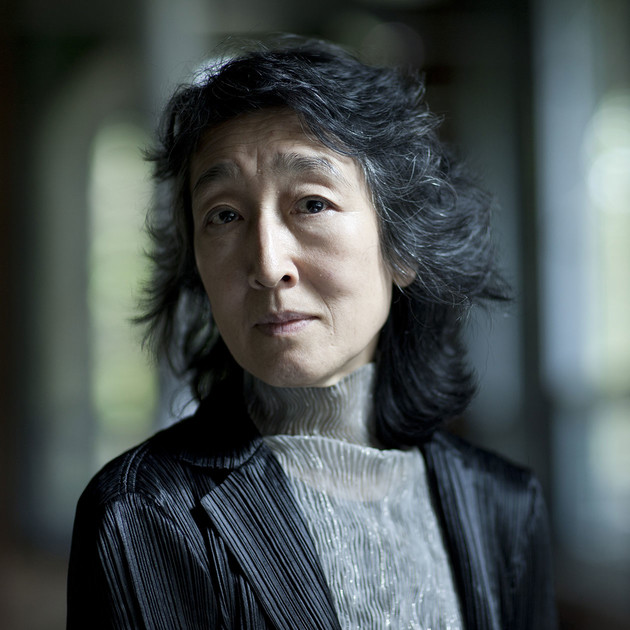Leonard Bernstein once said that his favourite piece of Stravinsky was whatever one he happened to be listening to. I have a similar feeling about Mozart piano concertos: I love them all in their turn, and last night I heard Mitsuko Uchida bring two of the greatest of them to life, as pianist and director, alongside the Mahler Chamber Orchestra.
The template is clearly the successful “Beethoven Journey” in which Leif Ove Andsnes spent four years touring the Beethoven piano concertos with the MCO, culminating in three scintillating Proms in the 2015 season. Combining two concertos with a 20th-century classic worked so well in the Andsnes concerts that it has been retained by Uchida for this new collaboration. In this case Bartók provided the filling in the Mozart sandwich, in the form of his entertaining but substantial Divertimento for string orchestra.
The new-ish wrinkle is that she is directing from the keyboard
According to Uchida’s website, this is already the seventh time this programme has been given this month, so it is not surprising that it sounded well grooved and immaculately presented, but it never felt run of the mill. Uchida has clearly never tired of this repertoire despite being associated with it for so many years, and is still finding fresh delight in Mozart.
The new-ish wrinkle is that she is directing from the keyboard, sitting, as did Andsnes, with her back to the audience, the lidless piano surrounded by players. Uchida (pictured below by Justin Pumfrey) made conducting the orchestral introductions interesting enough for us to want to see her on the podium for a whole concert. Her gestures were like her playing: poised, precise, elegant and with a joyful spontaneity. Uchida's open-handed downbeats made it look as if she was playing the orchestra like a giant piano. The only regret was that as she had her back to most of the audience we were deprived of seeing the most expressive of faces.
The two concertos we heard we No.17 in G major, K.453 and No.25 in C, K.503. The first was, unusually, written not for Mozart himself to play but for his student Barbara Ployer, which might account for its relatively modest technical demands. The orchestral opening was perky and suitably light, but in the first passages with piano there were some minor issues of balance, with the violin accompaniment threatening to outgun Uchida’s self-effacing playing. This seemed to resolve after the first few minutes, as everyone got accustomed to the room.
 The structure of the second movement, based around solo piano episodes, allowed a proper conversation to emerge between soloist and ensemble. Here, as throughout the concert, the playing by the woodwinds was quietly heroic, particularly by flautist Chiara Tonelli. The theme and variations finale had a palpable energy although the tempo, as elsewhere, was on the measured side of fast.
The structure of the second movement, based around solo piano episodes, allowed a proper conversation to emerge between soloist and ensemble. Here, as throughout the concert, the playing by the woodwinds was quietly heroic, particularly by flautist Chiara Tonelli. The theme and variations finale had a palpable energy although the tempo, as elsewhere, was on the measured side of fast.
The Bartók Divertimento of 1939, like Stravinsky’s music of the same period, gives no indication of the war clouds that were gathering, as Bartók prepared to flee Europe for an American exile. It is mostly genial music, although not without characteristic astringency. Rustic folksongs abound, although often couched in a sophisticated counterpoint, and the dialogues between solo section leaders and the rest of the section were wittily realised.
The orchestra stood to play (cellos excepted), and there was a clear physical engagement with the music. Playing without a conductor, much depended on the vibrant leadership of Matthew Truscott, who delivered a range of sounds from both his own instrument, and from the group. Playing with minimal vibrato, and biting into the strings in the climaxes, the MCO was also able to find some beautifully hushed textures in the slow movement.
Mozart’s 25th concerto saw the addition of two natural trumpets and period timpani to the orchestra, giving the deliberately placed chords of the opening a fresh timbre. Uchida’s playing was more outgoing than earlier, in keeping with Mozart’s approach, and her arpeggio accompaniment passages were glittering. Both the last two movements were treated with a good deal of rubato, Uchida finding different ways to articulate the rondo theme each time it appeared in the finale.
Although the concerto ended in glorious, loud celebration, Uchida brought us back to earth with a mesmerising Bach encore, a demonstration of an extraordinary ability to turn a large concert hall into an intimate recital space.















Add comment